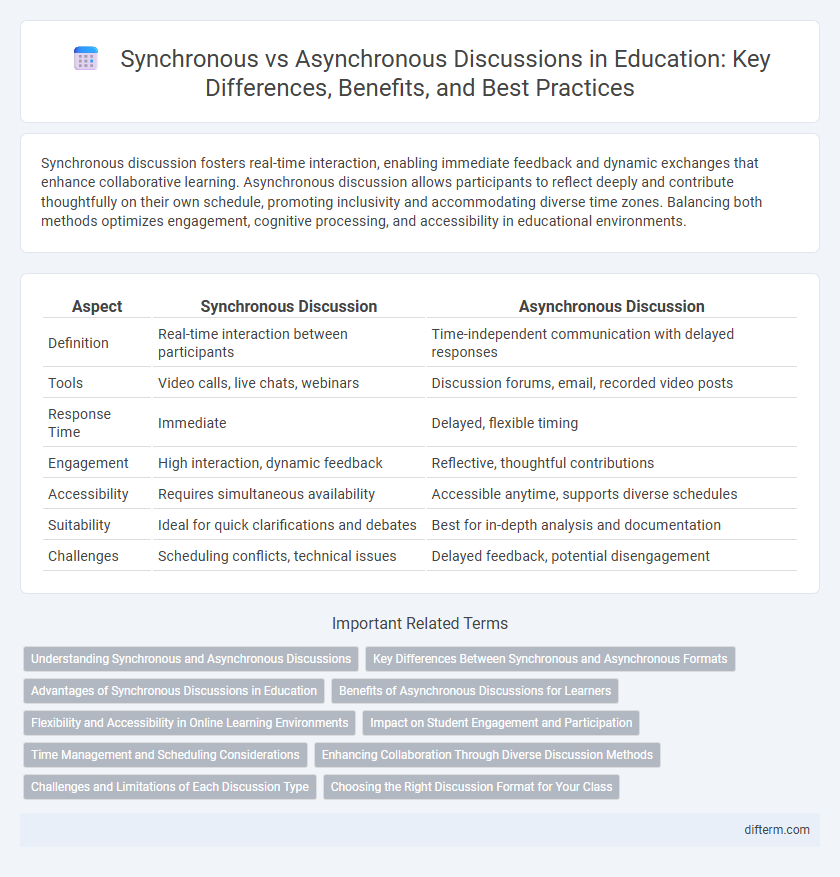Synchronous discussion fosters real-time interaction, enabling immediate feedback and dynamic exchanges that enhance collaborative learning. Asynchronous discussion allows participants to reflect deeply and contribute thoughtfully on their own schedule, promoting inclusivity and accommodating diverse time zones. Balancing both methods optimizes engagement, cognitive processing, and accessibility in educational environments.
Table of Comparison
| Aspect | Synchronous Discussion | Asynchronous Discussion |
|---|---|---|
| Definition | Real-time interaction between participants | Time-independent communication with delayed responses |
| Tools | Video calls, live chats, webinars | Discussion forums, email, recorded video posts |
| Response Time | Immediate | Delayed, flexible timing |
| Engagement | High interaction, dynamic feedback | Reflective, thoughtful contributions |
| Accessibility | Requires simultaneous availability | Accessible anytime, supports diverse schedules |
| Suitability | Ideal for quick clarifications and debates | Best for in-depth analysis and documentation |
| Challenges | Scheduling conflicts, technical issues | Delayed feedback, potential disengagement |
Understanding Synchronous and Asynchronous Discussions
Synchronous discussions occur in real-time, enabling immediate interaction and dynamic exchange of ideas, which enhances students' engagement and quick clarification of concepts. Asynchronous discussions allow participants to contribute at their own pace, promoting deeper reflection and critical thinking through extended time for responses. Understanding the differences helps educators design effective collaborative learning environments tailored to diverse student needs and learning outcomes.
Key Differences Between Synchronous and Asynchronous Formats
Synchronous discussions occur in real-time, allowing immediate interaction and instant feedback, which fosters dynamic engagement and collaboration among participants. Asynchronous discussions, however, enable participants to contribute anytime, supporting flexibility, thoughtful reflection, and accommodating diverse schedules. Key differences include timing of responses, level of interaction, and adaptability to learners' personal pacing, significantly impacting communication effectiveness and learning outcomes.
Advantages of Synchronous Discussions in Education
Synchronous discussions in education facilitate real-time interaction, promoting immediate feedback and dynamic exchange of ideas that enhance understanding and engagement. They foster a sense of community among learners by enabling spontaneous collaboration and active participation, which can improve communication skills and critical thinking. This immediacy supports timely clarification of concepts, reducing misunderstandings and accelerating the learning process.
Benefits of Asynchronous Discussions for Learners
Asynchronous discussions enable learners to engage deeply with course material at their own pace, promoting critical thinking and thoughtful responses. This flexibility supports diverse learning styles and accommodates varying schedules, enhancing accessibility for students globally. The ability to revisit and review discussion threads allows for continuous reflection and knowledge reinforcement, contributing to improved comprehension and retention.
Flexibility and Accessibility in Online Learning Environments
Synchronous discussions offer real-time interaction, fostering immediate feedback and dynamic collaboration, but often require fixed scheduling that can limit accessibility for diverse learners. Asynchronous discussions enhance flexibility by allowing students to participate at their own pace, accommodating different time zones and personal commitments, which increases inclusivity in online learning environments. Balancing both methods supports diverse learning styles and maximizes accessibility, ensuring equitable participation across varied learner demographics.
Impact on Student Engagement and Participation
Synchronous discussions foster immediate interaction and spontaneous exchanges, enhancing real-time student engagement and active participation. Asynchronous discussions offer flexibility, allowing students to reflect and contribute thoughtfully at their own pace, which can increase the depth of participation. Combining both formats maximizes student involvement by catering to diverse communication preferences and learning styles.
Time Management and Scheduling Considerations
Synchronous discussions require participants to be available simultaneously, which can pose challenges for time management due to fixed scheduling constraints but foster real-time interaction and immediate feedback. Asynchronous discussions allow flexibility, enabling participants to contribute at their convenience, enhancing individual time management and accommodating diverse schedules. Educators must balance these approaches to optimize engagement while respecting learners' varying availability and workload demands.
Enhancing Collaboration Through Diverse Discussion Methods
Synchronous discussions foster real-time interaction and immediate feedback, enhancing dynamic collaboration and engagement among participants. Asynchronous discussions provide flexible response times, allowing thoughtful reflection and deeper analysis, which supports diverse learning styles and sustained dialogue. Combining both methods maximizes collaborative potential by accommodating different communication preferences and promoting comprehensive knowledge exchange.
Challenges and Limitations of Each Discussion Type
Synchronous discussions face challenges such as scheduling conflicts, time zone differences, and limited time for reflection, which can hinder deep understanding and participation. Asynchronous discussions often suffer from delayed responses, potential miscommunication due to lack of immediate feedback, and difficulties in maintaining engagement over time. Both formats require careful design to address these limitations and promote effective interaction and learning outcomes.
Choosing the Right Discussion Format for Your Class
Synchronous discussions foster real-time interaction and immediate feedback, enhancing engagement and collaborative learning during live sessions. Asynchronous discussions offer flexibility, allowing students to reflect critically and contribute thoughtfully at their own pace, which supports deeper cognitive processing. Selecting the right format depends on course objectives, student availability, and the desired level of interaction, with a blended approach often maximizing learning outcomes.
synchronous discussion vs asynchronous discussion Infographic

 difterm.com
difterm.com